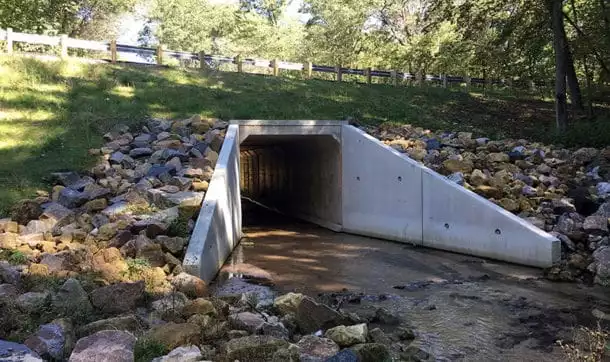Table of Contents
In this article, we will discuss what is a culvert?.
1. What is a Culvert?
A culvert may be defined as a structure that permits water to flow through a roadway, train, or other vehicle from one point to another point.
It is made by connecting two side banks on the soil. The culverts may be completed either with a concrete pipe, steel tubing, or other flexible material. In many circumstances, this structure is essential for the safe passage of water along a path or stream.
Many people can’t separate bridges and culverts. So, this article will make you clear what is a culvert? it’s part, types, etc.
2. Parts of Culvert
Any pipe or other flexible material that you utilize for culverts has two endings- one straight, and the other sloped. The slope or inclination will decide the speed at which water would cross through the culvert. the parts of a culvert are as follows:
• Pavement
• parapet
• Headwall
• Dingwall
• Crown
• Apron
• Road embankment
• Culvert inlet
• Culvert pipe
• Culvert outlet
• Culvert Foundation

3. Materials for Culverts
Asa result, culverts are commonly made with concrete. This construction method delivers many advantages over alternative choices such as an embankment pipe system, steel tube embankments, and buried pipe systems.
i. Concrete
ii. HDPE pipe
iii. PVC
4. Types of Culverts
The types of culverts are as follows:
a. Arch Culverts
The arch culvert is a precast or extended arch concrete structure commonly utilized as a part of the primary channel of the river for big spans and embankments.
The arch culverts may be made directly onto the banks or may be made in mounds, which give a firm and safe footing.
They are most usually utilized for low-clearance structures such as railway viaducts. The primary attraction of concrete arch culverts is their strength and ability to resist torrential downpours.
Although the construction cost may be expensive, at least they can be moved by crane.

b. Box Culverts
A box culvert made of a rectangular or circular-shaped box developed into a solid shell. The length of an arch culvert relies on its width and thickness. To manufacture the solid shell, different materials like crushed stone, corrugated steel, vinyl, wood, or insulated concrete are utilized. The concrete mix design of an arch culvert facilitates the expansion of the concrete directing to more suitable flexibility. However, they are at the risk of damage by water and also contain a lower ability than other types of culverts.
the bridge. The steel layer is generally considered as the strongest layer as compared to the other two. The concrete that forms the bottom surface is known as the overhangs.
They are usually wider than the rest of the concrete and hence they give strength to the structure. They are also known for their resistance to extreme weather conditions.
Solid Concrete Box Culvert
The solid concrete box culverts have a deep slot in the center that is wider than the length of the shell. The slot has a very deep curvature so that it can accommodate a vehicle lying in the same depth.
The depth inside the slot may vary depending upon the use of the vehicle. They are considered to be the cheapest among all types of culverts.

c. Top Heave Box Culverts
The top heave box culverts come with two parallel layers made from the steel support of the bridge. The steel layer is generally considered the strongest layer as compared to the other two. The concrete that forms the bottom surface is known as the overhangs. They are usually wider than the rest of the concrete and hence they give strength to the structure. They are also known for their resistance to extreme weather conditions.

d. Solid Concrete Box Culvert
The solid concrete box culverts have a deep slot in the center that is wider than the length of the shell. The slot has a very deep curvature so that it can accommodate a vehicle lying in the same depth.
The depth inside the slot may vary depending upon the use of the vehicle. They are considered to be the cheapest among all types of culverts.

e. Arch Concrete Bridge
This type of culvert is generally made up of a rounded or rectangular shape. It is used for both motor vehicles and bicycles. The concrete used for making these types of culverts can be expanded easily.
However, it is not easy to maintain them because they tend to break or crack due to heavy rains and strong winds. On the contrary, arch culverts do not experience much change in their width.

f. Pipe Culvert
It Is the simplest of all types of culverts, as discussed prior. You can use one pipe or more side by side to adjust the opening requirements based on the flow requirements. Pipes are available in different types of materials like Cast iron, PVC, Steel, or RCC.
Pipe culverts are very common due to the ease of installation. However, pipe culverts are only feasible for small types of drainage works or for low flows.

5. Advantages of Culverts
The advantages of culverts are as follows:
a. They are cheap.
b. It can support a greater weight load.
c. They provide adequate support to heavier vehicles.
d. It prevents erosion of road embankments.
e. It is used to divert water to the irrigation fields.
6. Disadvantages of Culverts
The disadvantages of culverts are as follows:
a. Installation of the culvert is complex.
b. It can limit aquatic organisms from freely shifting between upstream and downstream.
c. It can disturb the water flow.
| Read Also: Irrigation Tools List |

